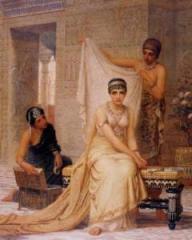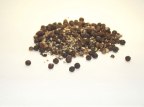But King Solomon loved many foreign women, as well as the daughter of Pharaoh: women of the Moabites, Ammonites, Edomites, Sidonians, and Hittites — from the nations of whom the LORD had said to the children of Israel,”You shall not intermarry with them, nor they with you. Surely they will turn away your hearts after their gods.” Solomon clung to these in love. And he had seven hundred wives, princesses, and three hundred concubines; and his wives turned away his heart. For it was so, when Solomon was old, that his wives turned his heart after other gods; and his heart was not loyal to the LORD his God, as was the heart of his father David. 1 Kings 11:1-5
No small harem
While King Solomon was on the one hand keenly concerned with international trade (which was favorably advanced by his treaty with Hiram of Tyre and now possibly with the queen of Sheba), his interest in spices also assumed a more personal and immediate focus. Though hard to imagine, his harem had reached an astounding proportion—seven hundred women of first rank (wives and princesses) and three hundred concubines, many of whom were non-Israelite worshipers of pagan gods. It seems that foreign trade brought with it “a toleration of heathen customs and religious views,”[1] which in turn created a constant demand for incense and spices.
Lamentably, Solomon himself gradually adopted a form of idolatrous worship involving the Sidonian goddess, Ashtoreth (a moon-goddess sometimes referred to as Aphrodite by the Greeks and Romans), as well as Milcom.1 Kings 11:8 records that he built high places dedicated to these pagan gods where his wives (and perhaps Solomon himself) could burn incense and sacrifice.
The timeless allure of perfume
On a purely physical level though, if there was a luxury near and dear to the heart of a woman…and her king, it might have been perfume. The origin of perfumery is hard to pinpoint, though the genesis of the word itself (i.e., per through fumus smoke) suggests it was first sensed when burning resins from fragrant woods such a bdellium, balsam, myrrh and frankincense. Records indicate that early perfumes took the form of an oily or solid buttery substance created by combining natural oils like olive, almond, sesame, or animal fats with a saturation of fragrances.[2] While used regularly by priests in their religious functions, higher classes such as the women of Solomon’s harem[3] also enjoyed such extravagances.
Perhaps the most revealing primary source concerning the power of such sensory delights is from the pen of Solomon himself in the “Song of Songs.” Possibly written early in his forty-year-reign, Israel’s king composed an epithalamium or nuptial song—an expression of a bridegroom to his bride. In chapter one, verses twelve through fourteen, the Shulamite bride speaks: “While the king is at his table, my spikenard sends forth its fragrance. A bundle of myrrh is my beloved to me, that lies all night between my breasts. My beloved is to me a cluster of henna blooms in the vineyards of En Gedi.”

Esther (public domain)
Another indication of what may have gone on within the confines of Solomon’s royal household is found in the book of Esther. Though hundreds of years later, it seems plausible that the procedures for preparing the initiates to a king’s harem might have been something similar. The Woman’s Study Bible (1995) notes: “During the Persian period and even among some Arabian tribes in this century, women would build a small charcoal fire in a pit in the floor. A fragrant oil, such as that from sandalwood, cloves, myrrh, or rose, would be placed in the cosmetic burner and heated in the fire. The woman would crouch naked over the burner with her robe draped over her head and body to form a tent. As she perspired, her open pores absorbed the fragrance of the oil. By the time the fire burned out, her skin and clothing would be thoroughly perfumed” (p. 786, “Beauty Preparations: Esther’s Make-Over”).
Considering the size and beauty demands of Solomon’s household, it is safe to conclude that the queen of Arabia’s treasure trove of spices would have been enticing, to say the least.
|
Common Ancient Spices |
||
Cinnamon |
Cinnamon is the dried inner bark of Cinnamomum verum, a small evergreen tree reaching about 15m tall. The spice itself is prepared by growing the tree for two years and then cutting it to ground level. New shoots form from the roots which are eventually stripped of their bark and left to dry naturally. Only the inner bark is used leaving long cinnamon strips which curl into rolls (“quills”) as they dry. Read more at Celtnet: http://www.celtnet.org.uk/recipes/spice-entry.php?term=Cinnamon | Native to Sri Lanka and southern India. |
| Cloves
|
Clove trees are members of the Myrtaceae (Myrtle) family. The name derives from French clou, a nail, as the dried buds, which forms the spice itself, vaguely resemble small irregular medieval nails in shape. | Native to Indonesia. Harvested primarily in the Spice Islands and Madagascar, today this spice is also grown in Zanzibar, India, and Sri Lanka. |
| Frankincense
|
A fragrant gum resin from trees of a genus (Boswellia of the family Burseraceae) of Somalia and southern coastal Arabia that has been used in incense for religious rites, perfumery, and embalming. | Native to southern Arabia and the Horn of Africa. |
| Myrrh
|
Myrrh is the aromatic resin of a number of small, thorny tree species of the genus Commiphora, which is an essential oil termed an oleoresin. Myrrh resin is a natural gum which has been used throughout history as a perfume, incense and medicine. It can also be ingested by mixing it with wine. It was so valuable in ancient times that it was, at times, equal in weight value to gold. (Wikipedia, Myrrh) | Indigenous to southern Arabia, Abyssinia, and the land of Punt (understood to be a region in East Africa at the south end of the Red Sea, opposite the modern Arabian port of Aden and extending southward along the Somali coast). |
Pepper (black) |
The dried fruit of the flowering vine, Piper nigrum, a member of the Piperaceae (pepper) family. | The pepper vine is a native of southwestern India and has been traded from there since prehistory. |
[1] Keil and Delitzsch Commentary on the Old Testament, 1 Kings 11:1.
[2] Early processing methods included pressing the ingredients (much like the way olives were pressed for oil), plants being placed in a sheet of cloth and twisted until the aromatic materials were drained from the source, and cold and hot steeping. http://www.wysinfo.com/Perfume/Perfume_history.htm.
[3] Much later than the time of Solomon, Classical Greeks saw the beginning of a distillation process which led to Greece becoming the first manufacturers of liquid perfume (not, however, the perfume associated with our modern day.) Some of their commonly used fragrances were rose, saffron, frankincense, myrrh, spikenard, cinnamon and cedar wood. Some of these may have been included in the offerings the queen of Sheba brought to Solomon hundreds of years earlier.








